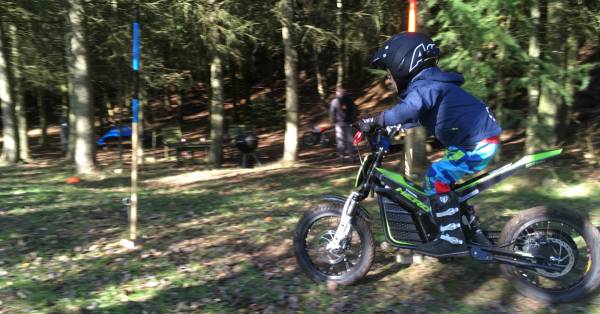When is it time, for the child to stand up on the pegs (riding standing up), instead of sitting on the motorcycle?
This is a question most ask themselves when junior starts for example in Trials.
The question is quite natural, because all places you look, you will read that it is an advantage for the child to stand on the pegs. The challenge is that this statement is not followed in just how you are to achieve this.
We will try to change that in this article.
It’s important to understand that not two children are alike, and therefore junior riders learn things differently – even when it comes to getting of the saddle.
Choose the right size motorcycle.
The body’s ABC stands for Agility, Balance and Coordination. It is important to remember the three pillars in any training – especially for children.
It’s also important that the child receives other physical “training input” than “just” riding a motorcycle. This can be achieved by playing in other ways at home, or for the child to attend other sports or physical activities.
We will try to return to this topic in a later article. Until then, there is a lot of inspiration to get on Youtube or the Internet in general, if you use the search parameter “Agility, Balance and Coordination.”

Choose the right size motorcycle.
It is important that the child has the right size of motorcycle. If the motorcycle is too small (or too big) it will be harder for the child to keep the balance on the bike when standing up.
You can adjust the ride height a bit, by modifying the bike with a higher (or lower) handlebar. This is often relevant on the small 12.5 “machines, that normally comes with a lower handlebar.
It’s a good idea to let the child try a bigger machine – you normally see a difference in riding style, if the child could benefit from this change.
It’s not just magic.
Although the size of the motorcycle is quite crucial, it is rarely enough to get the child on the pegs.
There is still training to do, and some persuasion to be made.
We have gathered some exercises that help you train the child to get up on the pegs.
- Single Track training.
We find that Single Track training is effective way to teach the child how to ride standing up.
There are normal fewer breaks and distractions from other riders when going on Single Track. This gives you and the child time to focus on the one task – to ride standing up.
You can set the difficulty of the “track” to suit the child’s level. Remember to set the difficulty so that it encourages the child to get on the pegs. You can read more about Single Track training in our article here. - Training with cones.
If you want to use more stationary training, it may be a good idea to use cones. Stationary training is defined as training in a closed area (preferable flat).
In the article “Cone Training – balance exercises” we describe how you can use cones for training balance and for standing on the motorcycle.
As the child develops skills, you might introduce slalom and 8 figure exercises. These exercises can help to further train the riders balance. - Training in sections.
When using Sections as an instrument to teach a rider to stand on the pegs, you might need to go about your business a bit differently.
It is important that you build a section that the child is very comfortable with. Start with a section that is straight on flat ground. You should not underestimate what the psyche does, that there are ribbon on both sides of the motorcycle.
Gradually, the level of the section can be raised. The most important thing is that the child experience victories, where a section can be traversed without the child sitting down or dabbing their feet.
Have patience.
Be patient – it will probably take some time. Also, be aware that it can go backward as well – and that’s okay too. Sometimes the child doesn’t have the strength or concentration for standing up.
A good idea may be to set an overall focal point together the child before the training starts. You can read about Training focus and Training capacity in this article.
Do not compare with other riders, for both your own and the riders sake. Children develop differently, also when it comes to riding a motorcycle.
The most important thing to celebrate the successes.
And as we say in Trial – Feet up! ?




 Why start with motorsport early?
Why start with motorsport early?
